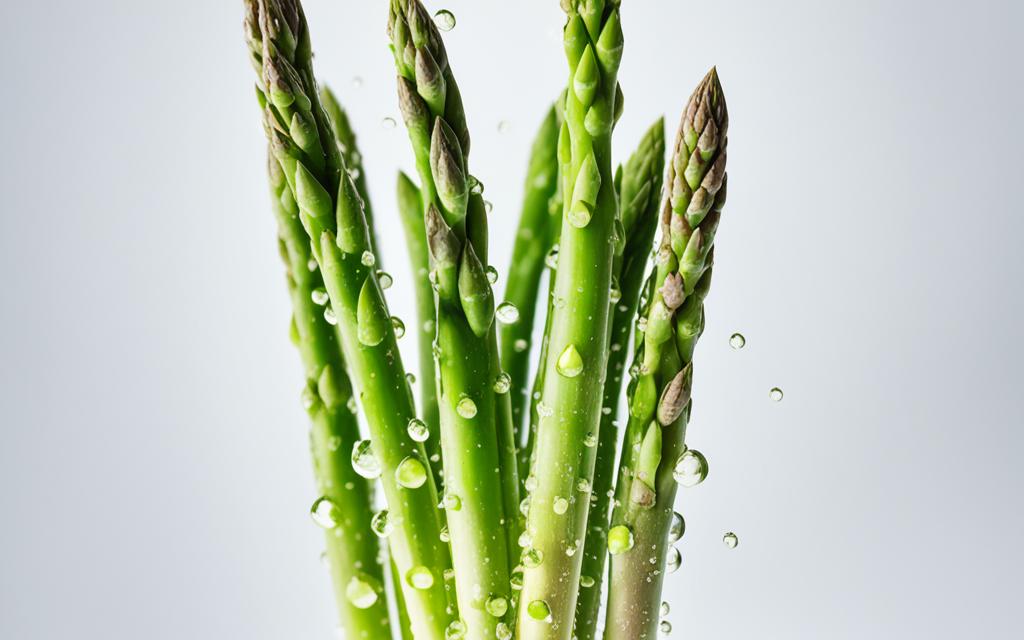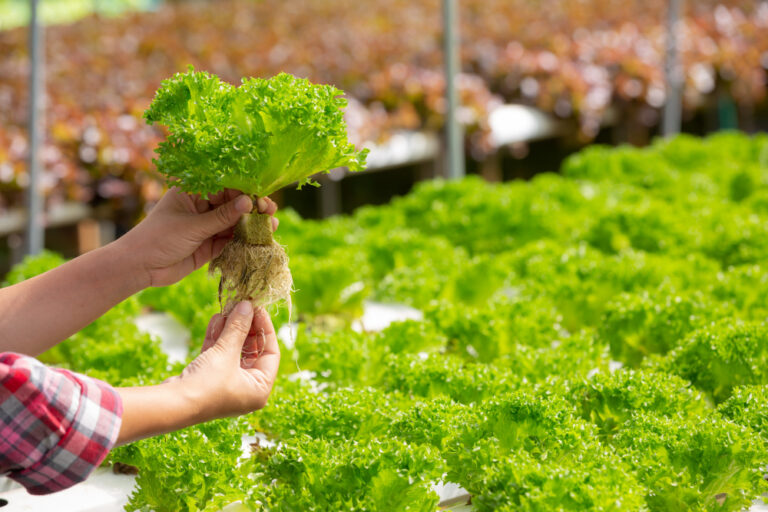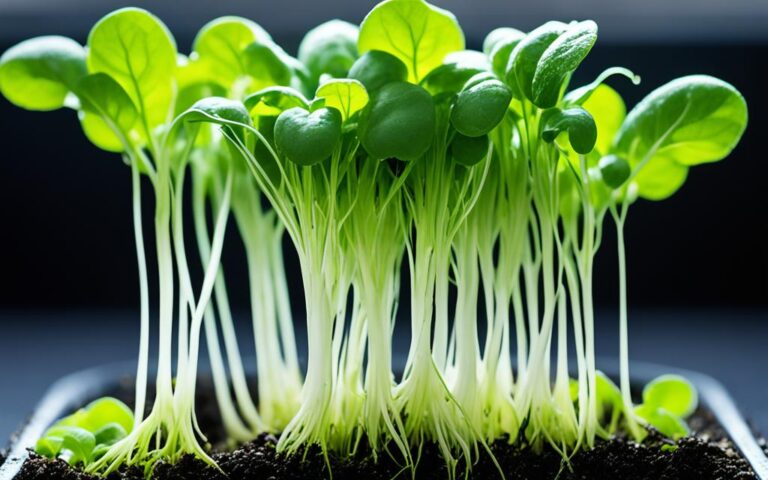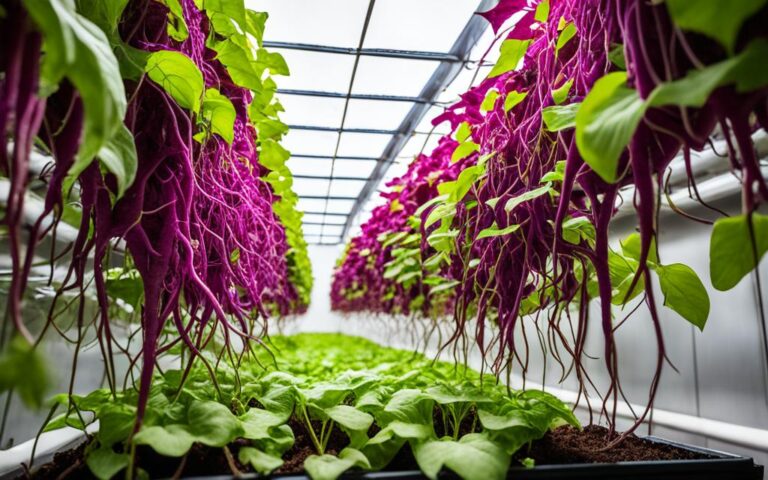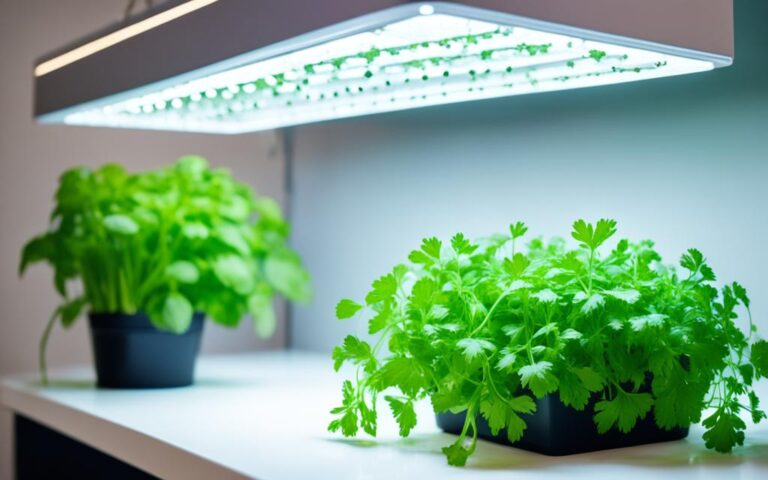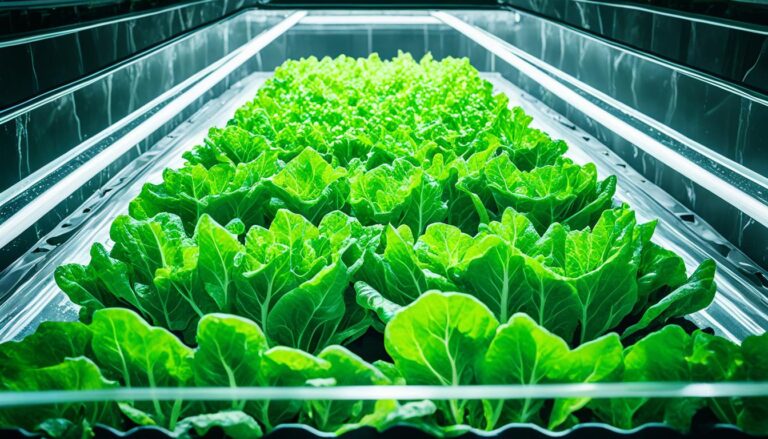Hydroponic Asparagus: Grow Tips and Benefits
Did you know hydroponic asparagus can produce up to 30% more than traditional farming? This method boosts the quality and amount of your asparagus harvest. It also makes growing easier. By using a controlled water setup, you can grow asparagus all year, no matter the soil.
For both new and experienced gardeners, hydroponic asparagus is a game-changer. It leads to quicker growth and healthier plants. This means you get a steady supply of fresh, tasty asparagus. With the right nutrients and water system, growing hydroponic asparagus is efficient and green.
Key Takeaways
- Hydroponic asparagus can yield up to 30% more produce than traditional soil-based cultivation.
- Hydroponic cultivation simplifies the growing process and allows for year-round production.
- Essential nutrients and a customized water-based system ensure healthier, faster-growing asparagus plants.
- Hydroponic asparagus cultivation offers an efficient and sustainable way to enjoy this versatile vegetable.
- Suitable for both seasoned gardeners and beginners, this innovative technique can elevate your gardening experience.
Introduction to Asparagus Crowns and Growing Techniques
Asparagus is a special plant from Western Asia with a long history. At its core are the asparagus crowns. These are the main part of the plant that includes the fleshy crown and dormant buds. Planting these crowns lets gardeners skip the long wait of growing from seeds. It takes about three years for seedlings to become productive plants.
To grow asparagus crowns well, they need lots of space and soil that drains well. For those with little outdoor space, hydroponic asparagus crowns systems are a great choice. These systems like the Dutch bucket or nutrient film technique offer controlled conditions and save resources.
Asparagus Crowns: An Overview of Growth and Development
Asparagus crowns are key to a healthy asparagus plant. They are the underground parts that have dormant buds. These buds grow into the spears we enjoy eating. By knowing how asparagus crowns grow and what they need, gardeners can help their plants thrive.
- Asparagus crowns grow deep roots that hold the plant in place and give it nutrients.
- The crown gets bigger over time, making more buds and spears each season.
- Taking good care of the crown is key for a big asparagus harvest every year.

“Asparagus crowns are the heart and soul of a thriving asparagus patch. By understanding their unique growth patterns, gardeners can unlock the full potential of this remarkable vegetable.”
Understanding the Root System and Nutrient Requirements
The asparagus fern’s root system is key to its growth and health. It has a complex network of roots that go deep into the soil. These roots hold the plant in place and help it get the water and nutrients it needs.
Asparagus Fern Root System: How It Supports Plant Growth
The roots of the asparagus fern are thick and can go as deep as 6 feet into the soil. They do many important jobs, including:
- Keeping the plant stable and upright as it grows.
- Getting water and nutrients like nitrogen, phosphorus, and potassium from the soil.
- Storing energy for the plant to use during the growing season.
Essential Nutrients for Asparagus: Ensuring a Well-Balanced Diet
Asparagus needs certain nutrients to grow well and produce a good crop. These nutrients are:
- Nitrogen helps with leaf growth and foliage.
- Phosphorus is important for roots, flowers, and plant health.
- Potassium helps with plant processes, fights diseases, and keeps the plant strong.
It’s important to give asparagus the right mix of nutrients. This helps the roots take in and use what the plant needs for a healthy, productive harvest.
Exploring Different Growing Methods
Gardeners and farmers have many hydroponic methods to grow asparagus. The deep water culture and Dutch bucket systems are two popular choices. Each has its own benefits for growing hydroponic asparagus.
Deep Water Culture: A Hydroponic Technique for Asparagus
The deep water culture (DWC) method suspends asparagus crowns in a nutrient-rich water solution. This lets the roots get the nutrients they need for strong growth. It’s great for young asparagus plants, giving them room to grow their roots.
Dutch Bucket Systems: A Popular Choice for Outdoor Gardens
Dutch bucket systems are also great for growing asparagus outdoors. They use buckets filled with a good soil mix, where the asparagus crowns are planted. This method ensures good air flow and easy water level checks, perfect for growing DWC asparagus.
By trying out these hydroponic methods, gardeners and farmers can pick the best one for their needs. Whether it’s a modern hydroponic setup or a traditional outdoor garden, there’s a method for everyone.
Tips for Growing Asparagus from Seeds
Asparagus is a perennial vegetable that can be grown from seeds. It offers a rewarding and exciting gardening experience. Whether you’re starting seeds indoors or directly in the garden, keep these key tips in mind for success.
First, pick the right asparagus variety for your climate and growing conditions. Popular choices include ‘Mary Washington,’ ‘Jersey Giant,’ and ‘Purple Passion.’ These varieties are bred for better disease resistance and more productivity.
- Soak the asparagus seeds in water for 24 hours before sowing. This helps soften the tough outer shell and boosts germination rates.
- Prepare the soil by adding compost or well-rotted manure. This gives asparagus plants the nutrients they need.
- Sow the seeds 1-2 inches deep and 12 inches apart. Keep the soil moist until they germinate, which can take 2-4 weeks.
- Once seedlings appear, thin them to the strongest plant every 12 inches. Provide consistent water and sunlight for the best growth.
With the right growing conditions and patience, you can start asparagus from seeds. Enjoy a bountiful harvest for years to come.
“Asparagus is one of the few perennial vegetables, meaning it can be harvested for many years once established. Starting it from seed takes a bit more time, but it’s a rewarding process.”
Why to Grow Asparagus
Asparagus is a tasty vegetable that’s also great for your health. It’s full of nutritional benefits perfect for any garden or hydroponic setup. This plant is loaded with vitamins, minerals, and antioxidants. These help keep you healthy and feeling good.
Nutritional Benefits
Asparagus is a top choice for nutrition. It’s full of vitamins A, C, E, and K, plus folate (vitamin B9) and fiber. These nutrients support your immune system, keep your skin healthy, help with blood clotting, and aid digestion. Plus, it’s low in calories and fat, making it a healthy option for those watching their weight or calorie intake.
Asparagus also has antioxidants that lower the risk of heart disease and some cancers. These antioxidants fight off harmful free radicals that can damage cells and cause inflammation.
“Asparagus is a superfood that should be a staple in any healthy diet. Its impressive nutrient profile and health benefits make it a fantastic choice for those looking to boost their overall well-being.”
So, growing asparagus is a great way to add nutrition to your garden or hydroponic setup. By growing this versatile vegetable, you get to enjoy its benefits of growing asparagus and nutritional benefits of asparagus. It’s a smart choice for why grow asparagus.
Why to Choose Hydroponics for Growing Asparagus
Asparagus is a versatile and nutritious vegetable that thrives in hydroponics. Farmers pick hydroponics for asparagus because it lets them control growing conditions. This leads to faster growth, more yields, and consistent harvests than soil farming.
Hydroponics lets farmers create a controlled environment. This indoor setting cuts down on pests and diseases, making for a sustainable asparagus crop. Plus, it means asparagus can be grown all year, giving a steady supply of this healthy veggie.
Another plus of hydroponic asparagus is the exact control over nutrients. Hydroponics delivers nutrients right to the roots, making sure asparagus gets what it needs. This means better growth and quality asparagus spears.
| Advantages of Hydroponic Asparagus | Benefits of Hydroponic Asparagus |
|---|---|
|
|
Overall, growing asparagus hydroponically has many benefits. It offers control and precision, leading to high-quality asparagus efficiently and reliably.
How to Grow Hydroponic Asparagus
Growing hydroponic asparagus needs careful planning and attention. You must pick the right site and hydroponic system. Choosing the best asparagus varieties and planting materials is also key for a good harvest.
Selection of Site for Set Up
When picking a spot for your hydroponic asparagus, look for a place near water and electricity. Make sure it has enough room for your system and is easy to get to for upkeep.
Selection of Hydroponic System
For growing asparagus, you can use the nutrient film technique (NFT) or deep water culture (DWC). The best system depends on your space, budget, and what you like.
Asparagus Varieties for Hydroponics
Top hydroponic asparagus varieties include Jersey Knight, UC 157 F1, Purple Passion, and Mary Washington. These are great for hydroponics because they grow well, resist disease, and taste great.
Planting Material for Asparagus
You can grow asparagus from seeds or crowns. Seeds are cheaper but take longer to grow. Crowns are quicker but might cost more.
Growing Medium
The growing medium is vital for hydroponic asparagus. You can use rockwool, perlite, or coconut coir. Each has its own benefits.
Maintain Optimal Growing Conditions
For hydroponic asparagus, keep the temperature, light, nutrients, pH, and EC levels right. Check and adjust these often to help your plants grow and produce well.
Benefits of Growing Asparagus in Hydroponics
Growing asparagus in hydroponics has many benefits over traditional soil methods. Hydroponics lets growers control the environment perfectly. This unlocks the full potential of this nutritious vegetable.
Growing asparagus hydroponically means faster growth and more produce. The right amount of nutrients and water, along with the perfect temperature, make asparagus thrive. This leads to steady and plentiful harvests all year.
Hydroponic asparagus is also great for the planet. It uses less water because the same water can be reused. This saves a lot of water. Plus, hydroponics lets growers use space wisely, making the most of every inch for their crops.
Hydroponics also lets growers adjust the nutrients for their asparagus. They can make sure the plants get just the right amount of nutrients like nitrogen, phosphorus, and potassium. This helps the plants grow strong and taste great.
| Benefit | Description |
|---|---|
| Faster Growth and Higher Yields | Precise control of growing conditions, such as temperature, nutrient delivery, and water supply, leads to accelerated growth and more abundant harvests. |
| Sustainable Production | Hydroponic systems conserve water through recirculation and efficient use of space, making them an environmentally-friendly option for asparagus cultivation. |
| Optimal Nutrient Delivery | The ability to fine-tune the nutrient profile of the growing solution allows growers to provide the ideal nourishment for asparagus plants, resulting in improved quality and yield. |
Using hydroponics, asparagus growers can have a steady supply of this healthy vegetable all year. They also help make farming more sustainable.
Growing Conditions for Hydroponic Asparagus
Growing hydroponic asparagus needs careful attention to its needs. This includes temperature, nutrients, and the right lighting. Each factor is key for a healthy and abundant harvest.
Temperature
Asparagus loves warm weather, doing best in 75°F to 86°F during the day. Keeping the temperature steady helps the plant absorb nutrients and grow well. At night, a bit cooler temperature is best, letting the plant rest and save energy.
Nutrients
Asparagus needs a lot of nutrients, especially nitrogen, phosphorus, and potassium. The ideal pH for the nutrient solution is 6.0 to 6.8. The electrical conductivity (EC) should be 2.4 to 3.0 mS/cm. With the right nutrients, the plant grows strong and healthy.
Light
Asparagus loves sunlight and needs a lot of light. Indoor growers should give it 12-14 hours of strong light daily. This helps with photosynthesis and growth.
By controlling temperature, nutrients, and light, growers can make the best environment for hydroponic asparagus.
| Growing Condition | Optimal Range |
|---|---|
| Temperature | 75°F to 86°F (day), slightly cooler at night |
| pH | 6.0 to 6.8 |
| Electrical Conductivity (EC) | 2.4 to 3.0 mS/cm |
| Lighting | 12-14 hours of high-intensity lighting per day |
“By carefully controlling the temperature, nutrient levels, and lighting conditions, hydroponic asparagus growers can create a truly optimal environment for their crops to flourish.”
Best Hydroponic Systems for Asparagus
When growing asparagus hydroponically, two systems are top choices: the deep water culture (DWC) and the ebb and flow (also known as flood and drain) systems. Each has its own benefits for growing this versatile vegetable.
Asparagus DWC System
The DWC system is great for asparagus because of its long life and thick roots. It suspends the asparagus crowns or roots in a tank full of nutrients. This keeps them constantly supplied with water and oxygen. It’s a simple system for beginners, making it a popular choice.
Asparagus Ebb and Flow System
The ebb and flow system moves nutrient solution through the growing medium. This lets the roots get the nutrients and oxygen they need. It’s also good for asparagus cultivation, but it might need more attention than the DWC system.
Both the DWC and ebb and flow systems work well for growing asparagus. But the DWC is easier for beginners because it’s simple and supports the plant’s growth well.
“Hydroponics offers a unique opportunity to cultivate asparagus, allowing gardeners to take advantage of the plant’s long lifespan and fleshy root system.”
Starting Your Hydroponic Asparagus Crop
Starting your hydroponic asparagus journey can begin with either asparagus crowns or seeds. Crowns give you a quick start but might bring soil-borne diseases. Seeds offer a cleaner start but take longer to grow.
Choosing the right planting material is key for a successful starting hydroponic asparagus crop. Whether you pick planting hydroponic asparagus crowns or seeds, focus on proper germination and growing medium preparation. Careful transplanting into the hydroponic system is also crucial.
Preparing Asparagus Crowns for Hydroponics
Using asparagus crowns? Check them for disease or damage first. Wash and trim any dead roots before putting them in your hydroponic setup. This ensures a healthy start and keeps pests out of your growing hydroponic asparagus setup.
Germinating Asparagus Seeds for Hydroponics
- Soak the asparagus seeds in water for 12-24 hours to enhance germination.
- Plant the pre-soaked seeds in a sterile, well-draining growing medium, such as coco coir or perlite.
- Maintain consistent moisture and temperature (around 70-85°F) to promote seed germination.
- Once the seedlings emerge, gradually acclimate them to the hydroponic environment before transplanting.
By following these best practices for starting hydroponic asparagus, planting hydroponic asparagus, and growing hydroponic asparagus, you’ll set the stage for a thriving crop.
Maintaining Your Hydroponic Asparagus
To keep your hydroponic asparagus thriving, you need to take good care of it. Make sure to flush the system every 7 to 10 days to avoid nutrient buildup. This can cause root rot and other problems. Also, watch your plants closely for any pests or diseases and deal with them quickly.
Checking the pH, electrical conductivity (EC), and nutrient levels in the hydroponic solution is key. This helps make sure your plants get the right balance of nutrients for healthy growth.
Use integrated pest management strategies and organic pesticides or fungicides to fight off pests. Keeping the growing area clean and well-ventilated is also important for your plants.
| Maintenance Task | Frequency | Importance |
|---|---|---|
| Flushing the system | Every 7-10 days | Prevents nutrient buildup and root rot |
| Monitoring plant health | Regularly | Addresses pests and diseases promptly |
| Checking pH, EC, and nutrient levels | Regularly | Ensures optimal growing conditions |
| Implementing pest management strategies | As needed | Protects plants from pests and diseases |
| Maintaining air circulation and sanitation | Regularly | Promotes overall plant health |
Putting in the effort to maintain your hydroponic asparagus will pay off. You’ll get a healthy and productive crop for a long time.
Conclusion
Hydroponic asparagus is a new and exciting way for gardeners and farmers in the U.S. to grow this nutritious vegetable. It lets growers have a steady supply of asparagus all year, no matter the outdoor weather.
Choosing the best asparagus types and hydroponic systems is key. Understanding and following the best practices for growing hydroponic asparagus is crucial for success. With the right methods, growers can make the most of this perennial crop and enjoy a big harvest.
If you’re new or experienced in hydroponic gardening, this article gives you the basics for growing great hydroponic asparagus. By using these tips and paying attention to asparagus’s needs, you can improve your hydroponic growing. Enjoy the many benefits of growing hydroponic asparagus.
